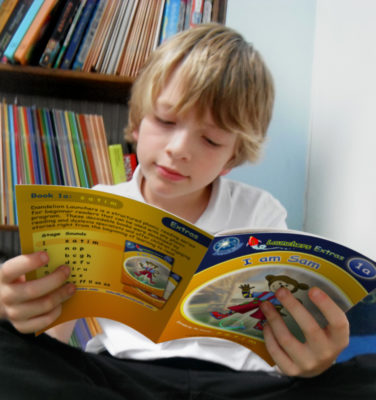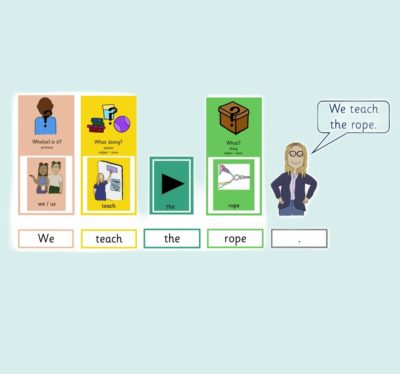Scarborough, H. S. (2001). Connecting early language and literacy to later reading (dis)abilities: Evidence, theory, and practice. In S. Neuman & D. Dickinson (Eds.), Handbook for research in early literacy (pp. 97-110). New York: Guilford Press.
Teaching the Reading Rope
The Reading Rope was developed by Dr. Hollis Scarborough to provide a framework for understanding the different skills that are necessary for skilled, accurate and fluent reading comprehension. SEN specialist and literacy consultant, Ann Sullivan, explains the best way to make sure we are all ‘teaching the rope’.

Written English is often described as a code, an alphabetic code where sounds are represented by letters in printed words. Learning how the code works, knowing the correspondences between the sounds and letters and mastering the key skill of blending is the foundation of learning to read and is called phonics. In England, time is dedicated to phonics lessons to teach children how to decode (read) words, both singly and in connected texts. Quite rightly, these are given a high priority within the curriculum, but phonics is, if you pardon the pun, not the whole story.
A skilled reader is often said to be one who can read fluently, that is with accuracy, automaticity, appropriate pace and prosody. When fluent readers read aloud it sounds like natural speech. I would like to add enjoyment to this statement; enjoyment that comes from decoding that comes easily and enables the reader to then understand and appreciate what has been read.
Scarborough’s Reading Rope
A good teacher or teaching assistant (TA) is aware of and understands the bigger picture of what makes a skilled reader. One of the best models of reading, which elegantly illustrates this, is Scarborough’s ‘Reading Rope’(1).
Scarborough’s rope analogy is that becoming such a reader is the intertwining of several strands of learning, just like strands in a rope. The two main strands are ‘recognizing printed words’ (incorporating the fibers of phonemic awareness, phonics and automaticity) and ‘language comprehension’ (incorporating the fibers of understanding spoken language structure, literacy conventions, having a good vocabulary, having background knowledge of the subject matter and verbal reasoning).
Good literacy instruction, therefore, should include all of the fibers, although not necessarily all in the same lesson. In fact, the ‘language comprehension’ aspects are commonly taught across the curriculum and in some cases at specific times, such as ‘story-time’ where an adult reads out loud to the children, modelling good language structure.
What is the Science of Reading?
Scarborough’s model arose from her work in a field that has come to be known as the ‘Science of Reading’ or SoR. Scarborough and others study specific aspects of reading through well designed and well executed research studies. Most importantly, these studies fulfil the criteria for being described as ‘scientific’ in their methodology, rather than being simply anecdotal observations, reflections on one or two children or people’s theories and ideas about what might be happening.
Critics have often accused those who follow the SoR of being ‘obsessed with phonics’, teaching children to decode and nothing else. Whilst I believe this has never been true (after all it was SoR folks who created the Rope and its sister model, the Simple View of Reading (2) in the first place) somehow, we SoR folks haven’t got a clear message across to everyone that our approach to teaching reading is wider than just phonics. It is unsurprising that some teachers and TAs continue to be confused about phonics and reading.
The Science of Reading in schools
In England, schools follow their choice of phonics program, and mainstream schools are guided in that choice by the DfE validation scheme. The validation scheme is specifically for programs aimed at initial instruction for 5-7 year olds. There is currently no validation scheme for programs aimed at learners with SEND and special schools do not have to choose from the list. Progress through any phonics program is structured and incremental and teachers are provided with a wealth of resources to ensure that they can deliver with fidelity. The approach to teaching the other aspects of reading though is less well defined. Perhaps this is where the misunderstandings arise as it is less obvious how this is happening.
Mainstream schools can learn much from colleagues in special schools in this regard. Our pupils with moderate to severe and complex special educational needs and disabilities, often have barriers to learning to read that are less apparent than the obvious difficulties in learning the alphabetic code and how to apply it to read. Teachers and TAs in special schools are skilled in and comfortable with delivering activities to children to develop their language skills supported by speech and language therapy colleagues.
So, how might mainstream schools spotlight the ‘language comprehension strand’ and teach those aspects in a structured and rigorous way?
Much of the answer to this question lies in curriculum design as they are embedded within it, but there is also a need for more training for all staff in how reading (in its widest and ropiest sense) is taught. The same is true for its partner, spelling.
Reading aloud
However, there is one teaching situation that happens routinely in schools across the country that affords an ideal opportunity to easily pull everything together or ‘teach the rope.’ It is, of course, when the child reads out loud to the teacher or TA. Then we can work, not only on phonics and decoding accuracy, but also on the other fibers that are so important to becoming a good reader.
The key to this would be ensuring that an evidence-led approach is taken, and a bank of appropriate activities are available for teachers and TAs to use with children in a planned and structured way. It makes sense that this work could be tied into reading a decodable book matched to the child’s level of phonic knowledge and skill. In this way, we could pull in specific activities that work on:
- vocabulary, with a focus on any words that are unknown to the children and a mind to expand the bank of words they have heard and know the meaning of
- language structure, with a focus on simple sentence structure, moving on to more complex aspects of spoken language
- background knowledge, with a focus on plugging any gaps in their knowledge and experience of the subject matter
- verbal reasoning, with a focus on reading and re-reading texts and talking ‘about and around the subject’ to read between the lines
We also need to support the development of reading fluency. Fluency practice can be incorporated into lessons, involving the reading and re-reading of challenging text out (out loud), reading to a partner, or by choral reading.
That this often happens on a one-to-one basis (or close to that), means that teachers and TAs can tune into the child’s strengths and weaknesses and plan a simple individualized pathway for each child.
We Teach the Rope

So, our mission has never been clearer. We teach phonics as the foundation of reading and work to develop children’s knowledge and use of spoken language so that we can braid them into skilled readers.
It’s time to reclaim reading instruction and proudly declare that we ‘Teach the Rope’!
- Scarborough, Hollis S., Neuman, Susan and Dickinson, David. “Connecting early language and literacy to later reading (dis) abilities: Evidence, theory, and practice.” Approaching difficulties in literacy development: Assessment, pedagogy and programmes 10 (2009): 23-38.
- Gough, Philip B., Tunmer, William E. “Decoding, Reading, and Reading Disability” Remedial and Special Education (1986)
#readingrope #scienceofreading #phonicsforsen #decodablebooks
* * *
Ann Sullivan has over 30 years’ experience in mainstream and specialist education. Based in the UK, her career includes roles as a KS1 and KS2 class teacher, SEN literacy teacher, school-based Special Educational Needs Coordinator (SENCO), an advisory teacher for pupils with special educational needs and a Specialist Leader in Education (SLE). She is on the writing team for pdnet (a network for those supporting children with physical disabilities in schools) and is a trustee of Speaking Out Forum (a charity that gives young people with SEND the chance to ‘have a voice’). Ann is now a literacy consultant, trainer and writer and creator of the Phonics for SEN programme.


